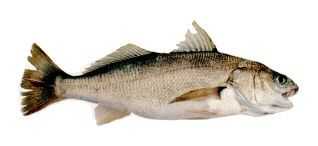Spotfin Croaker

Species Details
Roncador Stearnsii
Sciaenidae
Perciformes
Harbors, Bays, Sandy to Muddy Bottoms
6 - 10 lbs.
14" - 22"
Spotfin Croaker (Roncador stearnsii) Fish Description
The Spotfin Croaker appears to be top-heavy as a fish. They’re heavily bodied but have a steep head and a blunted snout. Their name, Spotfin Croaker, comes from the big black spot they have on the base of their pectoral fin. Unlike the other California croakers, however, the Spotfin Croaker doesn’t have barbels under its chin.
The Spotfin Croaker’s body is usually color silver gray with a blue shiny finish on the dorsal but white at the belly. Along its body, it has dark vertical wavy bars that run down its body which may look like blotches. Despite the spot on their fin, people sometimes have a tendency to confuse it with the White Croaker. One quick way to check is the number of dorsal spines. A Spotfin Croaker has 11 dorsal spines (or sometimes even only 10) whereas the White Croaker has 12-15.
They may also be called Golden Croakers but only achieve that color during mating season.
Diet and Size
Spotfin Croakers eat a variety of food. Using their large throat teeth, a Spotfin Croaker will crush a crustacean once it gobbles it up. They usually feed on clams, worms, and small crustaceans. They have a preference for burrowing pencil clams and ghost shrimps. Spotfin Croakers also love a good feast of fat innkeeper worms. If these aren’t available, bloodworms, mussels, and sandworms work too.
For the size of a Spotfin Croaker, they’re known to range between 14-22 inches. However, some Spotfin Croakers have been reported to reach 27.5 inches. As for weight, they range between 6-10 lbs. However, some have mentioned catching a Spotfin Croaker at around 14.1 lbs.
Interesting Facts about the Spotfin Croaker
- Spotfin Croakers change color during mating season.
- Because of this, Spotfin Croakers gained another name the Golden Croaker.
- The Golden Croaker is the moniker for the male Spotfin Croaker which turns gold during mating season.
- Female Spotfin Croakers have a black underbelly during mating season.
- Although Spotfin Croakers are valued for their meat, they are considered poisonous in other localities.
- Spotfin Croakers happen to migrate around. A lot.
- Some accounts would talk about how Spotfin Croakers used to be so abundant. They would form what people called Croaker Holes.
Spotfin Croaker – Fishing Techniques: How to Fish for a Spotfin Croaker
Before going out to fish for a Spotfin Croaker, the best place to go to is in Los Angeles Harbor. South from there, you’ll find yourself dealing with a lot of those Spotfin Croakers. Another place to head out to is Mexico where there seems to be a lot of them by the bays and piers.
When fishing for the Spotfin Croaker, it’s important to check the time of day. The Spotfin Croakers usually come out at around dusk time when the sun begins to set. Some anglers said that 80% of their trolling caught Spotfin Croakers. So, the best time to head out there is probably after lunch. Though, it highly depends on what part of the United States you’re coming from. If you’re in Los Angeles, maybe around late afternoon would be a good time.
Next, your bait. Spotfin Croakers love their burrowing pencil clams. But if those aren’t available, Bloodworms and Innkeeper Worms work just as well. Bloodworms, though frozen, are usually found in pet stores. Innkeeper Worms might be available on hand at the Harbor at their fishing shops or even some Fishing Charters nearby can tell you where to procure some.
Once you have your bait, time to get trolling. Trolling is a technique where you set up multiple lines with different hooks and sinkers. Once established, let the boat run around a bit. Depending on the fish (which in this case, the Spotfin Croaker), you’ll have to pay attention to the speed. Spotfin Croakers might be quite sensitive to speeds so slowing down won’t be a good idea. Plus, it’ll start snagging your lines if there’s a sudden shift in speed.
Spotfin Croaker Habitat and Distribution
Spotfin Croakers love shallow sandy areas. They usually stay near bays and the coast, coming closer around dusk time. Though depending on the coast, they might be in the deeper waters where waters are around 30 ft deep. When the tides hit, usually they hit the deeper waters as it prevents them from getting close to their favorite meal: corbinas, sand crabs, or even their pencil clams.
Another thing to look for is if that bay has a sandy bottom. Remember, Spotfin Croakers are suckers for burrowing pencil clams. And what better place to find them than in sandy to muddy bottoms? Though, if you don’t have pencil clams, a ghost shrimp will do the trick since they live in places like that too.







